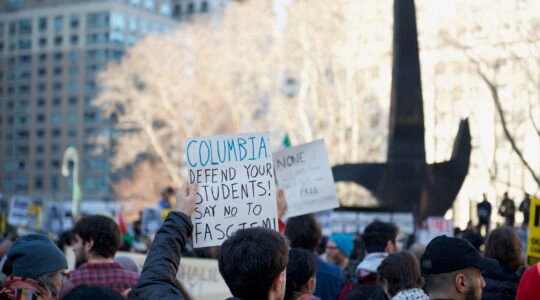Knesset member Yael Gelman is to be commended for proposing a bill to recognize Jews who risked their lives to help other Jews in the death camps, ghettos and forests of Nazi-occupied Europe. Such legislation is long overdue (“Should Yad Vashem Honor Righteous Jews?” Dec. 9).
I am not writing these words as a disinterested observer. My mother, Dr. Hadassah Bimko Rosensaft, who died in 1997, was one such heroine.
On the night of Aug. 3-4, 1943, when my mother, a dentist who had studied medicine in France in the early 1930s, arrived at Auschwitz-Birkenau with her family from their hometown of Sosnowiec in southern Poland, her parents, husband and 5 1/2-year-old son were sent directly into one of the gas chambers.
Two months later, because of her medical training, my mother was assigned to work as a doctor in the camp’s infirmary by the notorious Joseph Mengele, Birkenau’s chief medical officer. There, she was able to save the lives of fellow inmates by performing rudimentary surgeries for them, camouflaging their wounds and sending them out of the barracks on work details in advance of selections.
One incident among many: In September 1944, Ruta Krakowiak, a young Jewish inmate, became seriously ill. Diagnosed with scarlet fever, she was taken to the Birkenau infirmary from which patients deemed too sick to work were sent to their deaths in one of the camp’s gas chambers. One morning, even though she was still running a high fever, she recalled decades later, my mother, the inmate in charge of the infirmary, “took me aside and gave me clothes. She asked me to get dressed as fast as possible and to move quietly. She wanted me to join the few healthy inmates who were being transferred to Birkenau. I was told not to ask any questions, not to say a word.” Ruta Krakowiak, who would become Ruth Fenton, did as she was told, and lived.
In November of 1944, Mengele sent my mother and eight other Jewish inmates of Birkenau as a medical team to Bergen-Belsen, in Germany. Once again, the human potential for good in the face of evil manifested itself. Beginning with 49 Dutch children in December 1944, my mother organized what became known as a Kinderheim, a children’s home, within the concentration camp.
“At that time,” Hela Los Jafe, one of my mother’s fellow inmates, subsequently recalled in “Sisters in Sorrow: Voices of Care in the Holocaust” by Roger A. Ritvo and Diane M. Plotkin, “Bergen-Belsen started to be like Oswiecim [Auschwitz]. Transports came from all over, bringing thousands of people. Ada [my mother] walked from block to block, found the children, took them, lived with them, and took care of them.”
Among them were children from Poland, Czechoslovakia and elsewhere. Some had been brought to Belsen from Buchenwald, others from Theresienstadt. Together with a group of other women prisoners, my mother kept 149 Jewish children alive at Bergen-Belsen throughout the bitter winter and early spring of 1945.
According to Hela Jafe, “The children were very small and sick, and we had to wash them, clothe them, calm them and feed them. … Ada was the one who could get injections, chocolate, pills and vitamins. I don’t know how she did it. Although most of the children were sick, thanks to Ada nearly all of them survived.”
In January 1945, one of those children, Hetty Verolme, was almost 15, old enough to be considered an adult by the Germans. The inmates of her barracks were being evacuated to another camp. In her memoirs, “The Children’s House of Belsen,” she described how my mother, whom she called the doctor, took her by the hand to ask the camp Kommandant, Josef Kramer, if she could remain with the other children. “After he had scrutinized me,” Hetty wrote, “he nodded his approval to the doctor and barked ‘Los!’ (Get going). Before he could change his mind, the doctor and I ran for our lives back to the children.”
In 1981, my mother, who had been appointed to the United States Holocaust Memorial Council by President Jimmy Carter, chaired a session on medical rescue at an international conference on the liberation of the Nazi concentration camps. A survivor, Ray Kaner, took the floor to describe how she had been critically ill with typhoid at Bergen-Belsen in the winter of 1945. Her sister went to speak to my mother in the already overcrowded camp infirmary. Even though there was no room, Ray Kaner said, my mother had her brought to the infirmary and, “Somehow … my temperature dropped. I did survive the night.” And then she said to my mother, “I looked for you for many years — 36 years.”
The altruistic, life-saving bravery of individuals like my mother in the face of personal tragedy and unspeakable horrors, which are the subject of Mordecai Paldiel’s forthcoming book, “Saving One’s Own, Jewish Rescuers During the Holocaust” (Jewish Publication Society, April 2017), has been ignored for far too long. They deserve to be acknowledged role models for future generations every bit as much as those Christians and Muslims who saved Jews.
Menachem Z. Rosensaft is general counsel of the World Jewish Congress, and lectures on the law of genocide at the law schools of Columbia and Cornell Universities.
The New York Jewish Week brings you the stories behind the headlines, keeping you connected to Jewish life in New York. Help sustain the reporting you trust by donating today.




